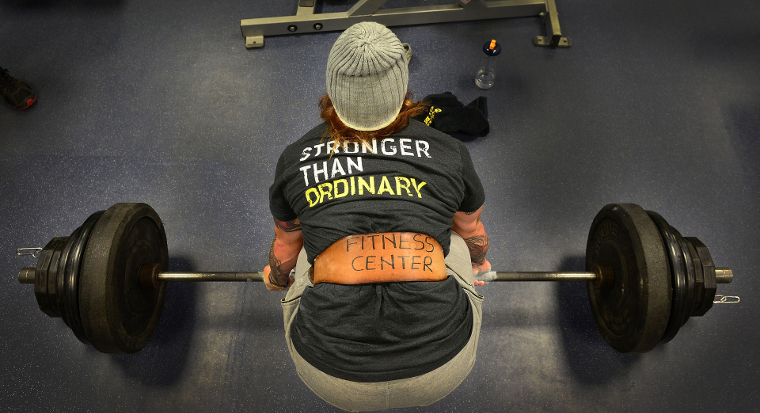When my wife’s and my twins were born, my disposable time evaporated. One adaptation I made was to cut weightlifting out of my life. Worth it, for sure, but an unfortunate loss. I figured my strongest days were behind me.

But when one door closes, another opens.
I’ve recently developed a lifting routine that has enabled me to increase my strength by 16% and even hit my new all-time max bench press. The best part? It has only involved 20 minutes of lifting per week.
Would you like to be stronger than you are but can’t (or don’t want to) spend hours in the gym? If so, the following method may just be for you.
The Method to Get 16% Stronger in 20 Minutes per Week
Minimal Time Commitment
When I say that I lifted for 20 minutes per week, that’s a slight overstatement. I actually lifted for just 16 minutes once every six days, on average. I did 40 such workouts over the course of 8 months (40 workouts in 240 days).
The Workout Routines
Each time I lifted—so once about every 6 days—I did one of these four simple routines:
Routine 1
Routine 2
Routine 3
Routine 4
So, the first time I lifted, I did Routine 1. About six days later, I did Routine 2, and so forth. Six days after completing Routine 4, I started over with Routine 1, and so on.
For each routine I chose exercises that tend to work many major muscle groups at once rather than smaller muscles in an isolated fashion. So, squats instead of wrist curls, for example. To keep my workout time to a minimum, I chose exercises that were likely to deliver the most bang for the buck.
Number of Sets and Reps
For each of the 3 or 4 above exercises within each routine, I did one warmup set of about 6 reps with half the weight I intended to lift.
After the warmup, for each exercise I aimed for just one set of 8-12 reps. I kept the reps fairly high (8-12) in order to decrease the chance of injury.
Based on how many reps I achieved, here’s what I recorded to do for that exercise the next time around (about 4 weeks later):
- Fewer than 8 reps? → Decrease weight by 5 pounds next time around.
- 8-11 reps? → Keep the weight the same. Aim for at least one more rep next time around.
- 12 or more reps? → Add 5 pounds next time around.
The only exceptions to this rule were for sit-ups and dips. In those cases, I did not do a warmup, and I just tried to do at least 1 more rep than the previous time.
Supersets for Efficiency
To keep my workout time to a minimum, I “superset” each workout routine. A superset is a form of weight training where you move quickly from one exercise to the next.
Taking the three exercises in Routine 1 as an example, here’s how I superset them:
- Routine 1 Superset
- Bench press warmup. Then immediately:
- Cable pulldown warmup. Then immediately:
- Bench press, 1 set of 8-12 reps. Then:
- Barbell upright row warmup. Then:
- Cable pulldown, 1 set of 8-12 reps. Finally:
- Barbell upright row, 1 set of 8-12 reps.
Intensity
During each exercise’s “1 set of 8-12 reps,” I lifted as intensely as I could. I can’t underestimate this important step. I believe it is the key to achieving solid results given the minimal time investment.
Following each workout, I felt very sore for 1-3 days. Though soreness can be uncomfortable, I’ve come to cherish it as a sign that the workout “worked.” (More on that below.)
Results
Over the 8 months, I lifted 40 times. That is, I did each of the four routines 10 times. I recorded my results for every set.
For each of the exercises, I made gains ranging from 4% (Barbell Upright Row) to 26% (Barbell Shrug). My overall gain averaged 16%.
After completing the 40 workouts, I tried for my new all-time one-rep max bench press which, as I mentioned, I achieved (easily, in fact). Think about that. I only benched 10 times in the course of 240 days. Each time was just one warmup and then 1 set of 8-12 reps. But I achieved a new max bench. That’s the 80/20 rule at work if I’ve ever seen it.
I can’t guarantee your results will be as good as mine. Then again, I can’t guarantee they won’t be better. . . .
If you’d like to try this weightlifting method, grab the following Weightlifting Web App. I designed it to enable me (and now you) to track progress through this workout routine digitally from a smartphone. Each time you record how many reps you completed, it auto-populates how many reps and of what weight you should aim for next time you lift:
Why this Method Works
How is it possible to make any strength gains, let alone 16% gains, by spending just 16 minutes on the gym floor once every six days?
At bottom, it’s simple, really. Building muscle involves two key components: damaging existing muscle fibers and then repairing them. This method does that:
- Real Muscle Damage. From the standpoint of building muscle, the whole point of going to the gym is to damage existing muscle fibers. I’m here to tell you that can be done, for sure, in 16 minutes . . . if you lift intensely. The significant soreness I feel 1-3 days after lifting is a sign that this (helpful) muscle damage has occurred.
- Real Muscle Repair. Muscle growth occurs when your body repairs damaged muscles. That process—the growth process—occurs not when you are lifting but during rest. By lifting so infrequently, you certainly allow your body plenty of time for real muscle repair.
Why Even Bother Getting Stronger?
Some people are plenty motivated to get stronger. They wear tank tops and listen to heavy metal music. Just kidding. Mostly.
But for those who have little to no interest in getting stronger, let me say a quick word about why I even care to get stronger and why you might, as well.
- Functional Strength? Sure, I want to be able to wrestle with the kids, carry the groceries, etc. But I think most of us have such functional strength without weightlifting. If you don’t, weightlifting would surely help.
- Physique? I’m not looking for a beach body. But even though my wife would love me no matter what, I’d rather look better than worse. I imagine that’s a fairly universal sentiment.
- Health? For me, health is a bigger motivation. Having some muscle is both a sign of health and a promoter of it.
- Flourishing. But for me, the biggest motivation is just overall human flourishing. The pursuit of what matters most in life involves developing as a whole person—intellectually, emotionally, interpersonally, spiritually, physically, etc. That’s not to say all areas deserve equal investment; they don’t. But to wholly neglect important aspects of our person is to fall short of the flourishing of which we are capable. This method of lifting is a leveraged way to develop physically.
Conclusion
You’re not going to become a bodybuilder with the method I describe above. But that’s not the point. If you have more time to devote to lifting, I’m sure there are methods that would make better use of additional time.
And even if you only have 16 minutes every six days to spare on weightlifting, it may be the case that there is a more optimal method than the one I describe above.
That said, this method enabled me to make meaningful strength gains with extremely minimal time investment for reasons that make sense to me. It might just work for you, as well—and leave you with plenty of time for life’s other worthy pursuits.
Question: Do you have any strength-gaining hacks? You can leave a comment by clicking here.
If you liked this post, why not join the 5,000+ subscribers who receive blog updates on how to have more time and money for what matters most? Sign up here.
